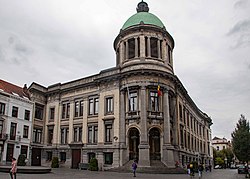Molenbeek-Saint-Jean
| |
|---|---|
 | |
| Coordinates: 50°51′28″N 04°18′57″E / 50.85778°N 4.31583°E | |
| Country | |
| Community | Flemish Community French Community |
| Region | Brussels-Capital |
| Arrondissement | Brussels-Capital |
| Government | |
| • Mayor | Catherine Moureaux (PS) |
| • Governing party/ies | PS – MR |
| Area | |
• Total | 6.02 km2 (2.32 sq mi) |
| Population (2020-01-01)[1] | |
• Total | 97,979 |
| • Density | 16,000/km2 (42,000/sq mi) |
| Postal codes | 1080 |
| NIS code | 21012 |
| Area codes | 02 |
| Website | molenbeek.irisnet.be/fr (in French) molenbeek.irisnet.be/nl (in Dutch) |
Molenbeek-Saint-Jean (French, pronounced [molœnbek sɛ̃ ʒɑ̃, -bɛk -] ) or Sint-Jans-Molenbeek (Dutch, pronounced [sɪɲˈtɕɑns ˈmoːlə(m)ˌbeːk] ), often simply called Molenbeek, is one of the 19 municipalities of the Brussels-Capital Region, Belgium. Located in the western part of the region, it is bordered by the City of Brussels, from which it is separated by the Brussels–Charleroi Canal, as well as by the municipalities of Anderlecht, Berchem-Sainte-Agathe, Dilbeek, Jette, and Koekelberg. The Molenbeek brook, from which it takes its name, flows through the municipality.[2] In common with all of Brussels' municipalities, it is legally bilingual (French–Dutch).
From its origins in the Middle Ages until the 18th century, Molenbeek was a rural village on the edge of Brussels, but around the turn of the 19th century, it experienced major growth brought on by a boom in commerce and manufacturing during the Industrial Revolution.[3][4][5] Its prosperity declined after the Second World War, owing to deindustrialisation, leading to extensive investment and regeneration. Experiencing a strong movement of immigration, mainly Moroccan, from the 1950s and 1960s, Molenbeek became increasingly multicultural with a minority Muslim population.[6][7] In the 2010s, it gained international attention as the base for Islamist terrorists who carried out attacks in both Paris and Brussels.[8][9][10][11][12]
Molenbeek is a mostly residential municipality consisting of several historically and architecturally distinct districts.[13][14] As of 1 January 2022[update], the municipality had a population of 97,697 inhabitants.[15] The total area is 6.02 km2 (2.32 sq mi), which gives a population density of 16,268/km2 (42,130/sq mi), twice the average of Brussels.[15] Its upper area is greener and less densely populated.
- ^ "Bevolking per gemeente op 1 januari 2020". Statbel.
- ^ Demanet & De Zuttere 2023, p. 6–7.
- ^ Charruadas 2005.
- ^ Steffens 2007.
- ^ Cite error: The named reference
:2was invoked but never defined (see the help page). - ^ Torrekens 2007.
- ^ "781.887 musulmans vivent en Belgique: découvrez la carte, commune par commune". sudinfo.be (in French). Retrieved 26 September 2021.
- ^ Levitt, Matthew (27 March 2016). "My Journey To Brussels' Terrorist Safe Haven". Politico.
- ^ "Brussels attacks: Molenbeek's gangster jihadists". BBC. 24 March 2016. Retrieved 13 April 2016.
- ^ "The Belgian neighborhood indelibly linked to jihad". The Washington Post. 15 November 2015. Retrieved 13 April 2016.
- ^ "Beleaguered Molenbeek struggles to fend off jihadist recruiters". The Times of Israel. 3 April 2016. Retrieved 13 April 2016.
- ^ "World points to "jihad Capital" Molenbeek". Het Nieuwsblad. 16 November 2015. Retrieved 13 April 2016.
- ^ Cite error: The named reference
:10was invoked but never defined (see the help page). - ^ Cite error: The named reference
:11was invoked but never defined (see the help page). - ^ a b "Molenbeek-Saint-Jean | IBSA". ibsa.brussels. Retrieved 24 September 2021.




